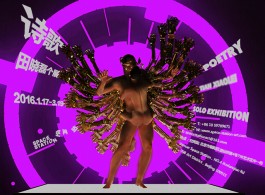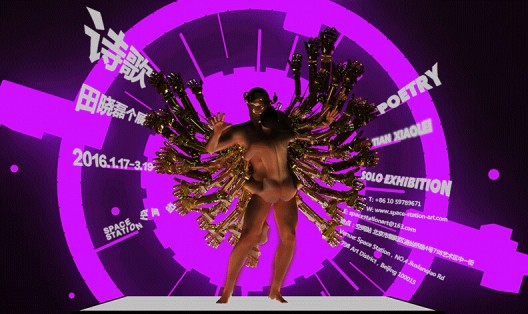Cultural Spiral of the Bio-mechanical Age: Cyborg, Posthumanism and Embodiment —— Tian Xiaolei’s Solo Exhibition
Text: Fu Xiaodong
What questions are raised in Tian Xiaolei’s art? Do these questions go beyond what’s been previously discussed and provoke us to ponder further?
1.Posthumanism
Posthumanism indicates the ontological shift of “the increasing technologicalisation of human” and “the personification of technology.” On the border between human and nonhuman, in the open-endedness and a history that is forward-looking, how do the truly ground-breaking things really emerge in the fissures of time? The posthuman is an artificial entity designed by humans, a bio-human emerged through unnatural heredity. It’s mechanically or electronically controlled while to a certain degree maintaining its biological function, a biochemical human in a state of hybrid of man and substances. It exceeds the limits of stamina, intelligence and vitality of human functionality, breaking through the present constraints to evolve into a perfect, infinite super-human. It’s the technological adaptation of ascending to immortality, a sinful representation of the overlapping of the fruits of intelligence and immortality of the Garden of Eden.
2. Cyborg
Cyborg originates from cybernetics. Haraway defines the cyborg ontology in Cyborg Manifesto: “A cyborg is a cybernetic organism, a hybrid of machine and organism, a creature of social reality as well as a creature of fiction.” This concept of cyborg in Haraway’s theories break down the rigid boundaries separating “human” from “animal,” “human” from “machine” and the “physical” from “non-physical,” and in doing so it further undermines all the mythology of nation and race, gender and class, nature and artificiality, spirituality and body, organic and non-organic invented by human itself. It comes into being from the complex, intertwining situations of science, technology, politics, economics and ethics. Haraway reiterates the story of identity with genetically modified creatures. The genetic modification of potatoes, fireflies and tobacco invalidates the conventional dualistic separational standards. In Haraway’s words, everyone of us is a cyborg, since we mingle with technology on a daily basis while technology and the human body integrate each other.
3. Embodiment
Disembodiment claims the essential vehicle of life is not body itself, but the abstract information or informational mode. Embodiment can be traced to the shift in linguistics of the early 20th century. Lakoff borrowed the term “embodiment” from psychology and philosophy to highlight the crucial role the body plays when shaping the spirit. Don Ihde proposed three approaches of understanding the body in his Bodies in Technology: 1) The phenomenological body in a present, objective world. 2) A socially and politically constructed postmodern body that is complicated by the impositions of psychological, political and cultural reconstructions. 3) the body that’s mutually corresponding to and fulfilled by technology. While the virtual body is connected to the Internet in a cyborg space, it is regarded that human exists simultaneously in two kinds of realities with not only its body existing in the physical realm but also its mind interacting with physical substances. The embodied posthuman body is a trans-border body. The body that’s mutually connected to mechanical devices, unroots the inherent anthropocentrism and self-deification. Merleau-Ponty proffers the concept of “embodied subjectivity” which sees humans as from neither a disembodied mentality, nor extremely complex, but a living, active creation, whose subjectivity is fulfilled by material interactions between the body and the world. The human perception originates from “I can,” which is “body – subject,” a body that coexists with the world, and therefore “I am” to interact with the world. In Tian Xiaolei’s works, the virtual body contains endless digital plasticity. In the point of view of posthuman subject, the essence of technology is neither positive nor negative, but rather a series of possibilities to facilitate the becoming of the posthuman. The body and technology entangle inevitably, becomes an embodied entity through mass amounts of data. The posthuman subject is a subject in flux, a subject in the gapped body, it’s not fixed upon a concept nor substance, but an in-between state.




